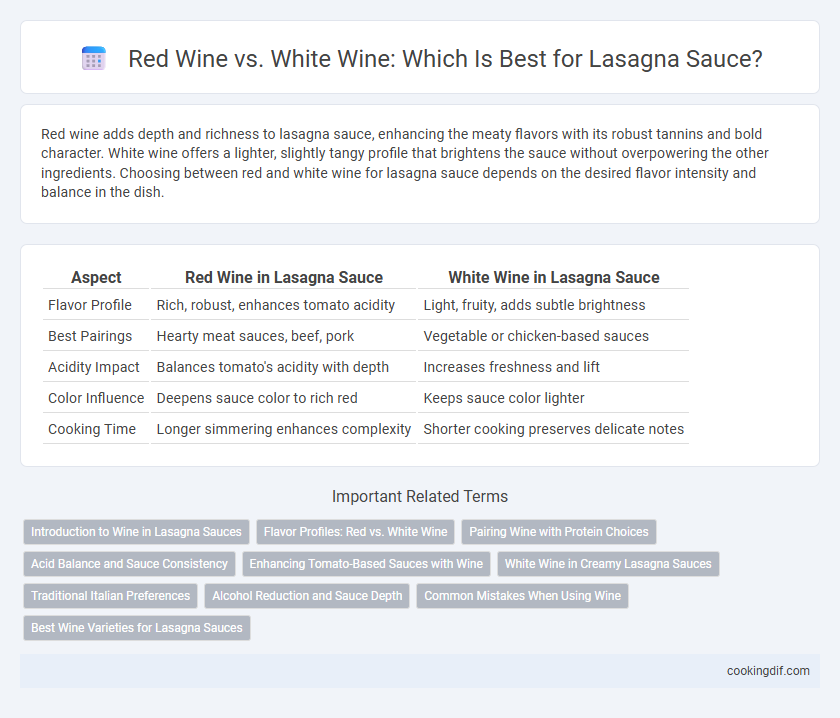Red wine adds depth and richness to lasagna sauce, enhancing the meaty flavors with its robust tannins and bold character. White wine offers a lighter, slightly tangy profile that brightens the sauce without overpowering the other ingredients. Choosing between red and white wine for lasagna sauce depends on the desired flavor intensity and balance in the dish.
Table of Comparison
| Aspect | Red Wine in Lasagna Sauce | White Wine in Lasagna Sauce |
|---|---|---|
| Flavor Profile | Rich, robust, enhances tomato acidity | Light, fruity, adds subtle brightness |
| Best Pairings | Hearty meat sauces, beef, pork | Vegetable or chicken-based sauces |
| Acidity Impact | Balances tomato's acidity with depth | Increases freshness and lift |
| Color Influence | Deepens sauce color to rich red | Keeps sauce color lighter |
| Cooking Time | Longer simmering enhances complexity | Shorter cooking preserves delicate notes |
Introduction to Wine in Lasagna Sauces
Red wine adds depth and richness to lasagna sauces, enhancing the savory flavors of tomato and meat with its robust tannins and fruity notes. White wine introduces a lighter, slightly acidic profile that brightens the sauce and complements creamy or vegetable-based lasagna varieties. Selecting the proper wine depends on the sauce base, with red wine ideal for traditional meat sauces and white wine suited for bechamel or seafood-infused recipes.
Flavor Profiles: Red vs. White Wine
Red wine offers robust, fruity, and tannic flavor profiles that enhance the richness of tomato-based lasagna sauces, adding depth and complexity. White wine provides a lighter, acidic, and crisp character, complementing creamy or bechamel sauces by balancing richness without overpowering other ingredients. Choosing between red and white wine for lasagna sauce depends on the desired flavor intensity and the base ingredients in the sauce.
Pairing Wine with Protein Choices
Red wine, such as Chianti or Sangiovese, pairs exceptionally well with tomato-based lasagna sauces featuring beef or pork due to its robust tannins and acidity that complement rich meat flavors. White wine, like Pinot Grigio or Chardonnay, suits lasagna with chicken or seafood sauces by balancing lighter protein profiles and creamy textures without overpowering them. Selecting the wine based on the primary protein enhances the overall flavor harmony between sauce and dish.
Acid Balance and Sauce Consistency
Red wine enhances lasagna sauce with deeper acidity, balancing rich tomato flavors while maintaining a thicker consistency due to its tannins. White wine introduces brighter acidity and a lighter texture, resulting in a tangier sauce that can be thinner in consistency. Choosing between red and white wine influences the sauce's acid balance and thickness, directly impacting the lasagna's overall flavor profile.
Enhancing Tomato-Based Sauces with Wine
Red wine enriches tomato-based lasagna sauces by intensifying the sauce's deep, robust flavors and adding subtle tannins that complement the acidity of the tomatoes. White wine introduces a brighter, slightly acidic note that can lighten the sauce while enhancing its fresh, fruity undertones. Choosing red wine typically results in a richer, more complex sauce, whereas white wine offers a crispness that elevates the overall balance of the dish.
White Wine in Creamy Lasagna Sauces
White wine enhances creamy lasagna sauces by adding a subtle acidity that balances the richness of bechamel and cheese layers, creating a harmonious flavor profile. Its light, fruity notes complement the smooth texture without overpowering the dish, unlike red wine, which can introduce heavier tannins and robust flavors less suited for delicate sauces. Using dry white wine varieties such as Pinot Grigio or Sauvignon Blanc optimizes sauce depth while preserving the creamy consistency essential to classic white lasagna recipes.
Traditional Italian Preferences
Traditional Italian lasagna recipes typically favor red wine for sauce preparation, enhancing the rich, meaty flavors with robust Tuscany or Chianti varieties. Red wine's depth complements tomato-based sauces, balancing acidity and intensifying the dish's savory profile. White wine, while occasionally used in lighter lasagna variants, remains less common in classic regional Italian cuisine.
Alcohol Reduction and Sauce Depth
Red wine enhances lasagna sauce with deeper, richer flavors and higher tannin content, which intensify as alcohol reduces during cooking, creating a robust, complex taste profile. White wine, while lighter and more acidic, offers subtler fruit notes and brightens the sauce without overpowering other ingredients, with its alcohol also diminishing to soften sharpness. The choice between red and white wine impacts sauce depth and complexity, influenced by alcohol reduction that concentrates flavors and balances acidity.
Common Mistakes When Using Wine
Using red wine for lasagna sauce often leads to overpowering bitterness if added too early, whereas white wine can cause a harsh, acidic taste when not reduced properly. Common mistakes include using cheap, overly tannic red wines that clash with tomato flavors or using sweet white wines that disrupt the sauce's balance. Proper wine selection and gradual simmering help achieve the ideal harmony between the wine and tomato-based sauce.
Best Wine Varieties for Lasagna Sauces
Red wine varieties like Chianti, Sangiovese, and Merlot enhance lasagna sauces with rich, earthy flavors and robust acidity that complement tomato-based recipes. White wines such as Pinot Grigio and Sauvignon Blanc offer a crisp, bright contrast ideal for creamy bechamel or white sauce lasagnas, balancing richness without overpowering. Selecting the best wine for lasagna sauce depends on sauce type, with red wines favored for meat and tomato sauces and white wines excelling in lighter, cheese-based variations.
Red Wine vs White Wine for sauce Infographic

 cookingdif.com
cookingdif.com